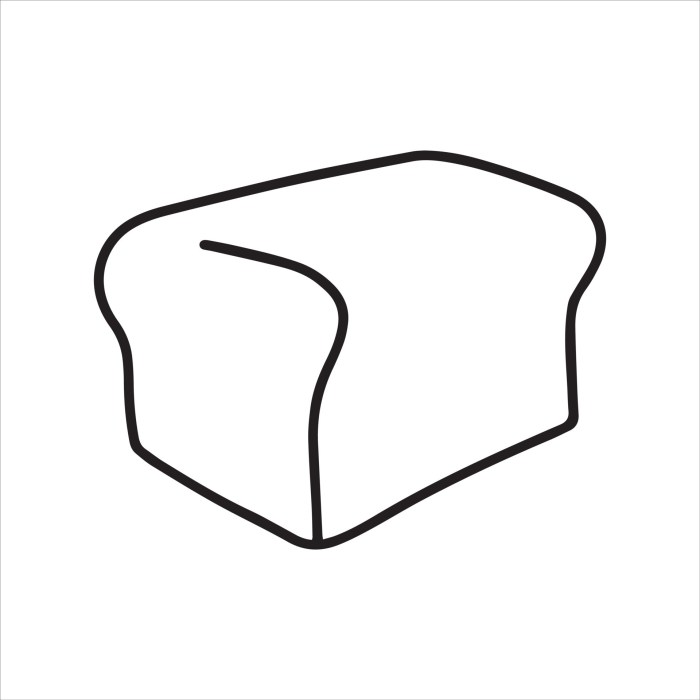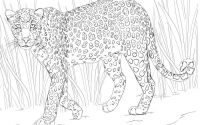Easy Bread Drawing Big A Simple Guide
Sketching Techniques for Large Bread Drawings

Easy bread drawing big – Creating a large-scale drawing of a loaf of bread presents unique challenges and opportunities. The scale allows for intricate detail and a more immersive experience for the viewer, but requires careful planning and execution. This section details effective techniques for achieving a realistic and visually appealing large bread drawing.
Just like how a simple sketch can depict a large, delicious loaf of bread, perspective is key. Mastering simple shapes, like those found in an easy bread drawing big, translates to other projects. For instance, understanding how to create depth is crucial, and a great exercise for this is learning to draw easy drawing of a set of stairs , which helps you grasp the concept of receding lines.
Then, you can apply that skill back to your easy bread drawing big, adding dimension and realism.
Step-by-Step Guide for Drawing a Large Loaf of Bread Using Simple Shapes, Easy bread drawing big
Begin by establishing the overall form of the loaf using basic geometric shapes. Imagine the bread as a combination of cylinders, ovals, and cubes. Lightly sketch these shapes onto your large paper, paying close attention to the proportions and overall perspective. Refine these initial shapes gradually, adding curves and details to create the characteristic contours of the bread.
Next, focus on the crust, using shading to indicate texture and depth. The crumb can be suggested through lighter shading and subtle variations in tone. Finally, add any final details such as cracks or flour dusting to complete the illustration. Remember, working in stages and building up the details incrementally is key to a successful large-scale drawing.
Comparison of Sketching Tools for Large-Scale Drawings
The choice of sketching tools significantly impacts the outcome of a large bread drawing. Charcoal offers rich, dark tones and easy blending, ideal for capturing the deep shadows and textures of a crust. However, it can be messy. Graphite pencils, ranging in hardness, provide versatility, allowing for both delicate lines and bold shading. Larger pencils may improve efficiency for broad strokes.
Conté crayons offer a blend of both charcoal and graphite characteristics, allowing for expressive lines and smooth shading. Each tool allows for a unique aesthetic. The artist’s preference and desired effect should guide the selection.
Perspective and Proportion in Large Bread Drawings
Accurate perspective and proportion are crucial for depicting a realistically sized loaf of bread. Consider the vanishing point when working with a large format. This ensures that the bread appears to recede into the background realistically. Establishing a clear horizon line is helpful in maintaining consistent perspective. Proportion is critical.
Accurate measurements and consistent ratios throughout the drawing are essential for a believable representation. Using a ruler or grid system for initial measurements can help maintain accuracy and proportion throughout the larger scale drawing. Consider comparing the size of the bread to a recognizable object, such as a plate or a hand, for reference. This helps to create a sense of scale and believability.
Adding Detail and Texture to the Bread Drawing

Elevating a simple bread sketch to a truly captivating piece hinges on the skillful application of texture and shading. By mimicking the subtle nuances of a baker’s craft, we can imbue our drawings with a palpable sense of realism and warmth, inviting the viewer to almost taste the freshly baked goodness. This involves understanding the interplay of light and shadow, and how different bread types exhibit unique textural characteristics.The successful rendering of bread texture relies on a nuanced approach to shading and line work.
Careful observation of the bread’s form—its curves, creases, and the way light interacts with its surface—is paramount. Understanding the underlying structure of the bread, including the crumb, crust, and any air pockets, allows for a more accurate and convincing representation. For instance, the rough, cracked surface of a sourdough contrasts sharply with the smooth, slightly glossy skin of a baguette.
These differences must be reflected in the choice of shading techniques and line weight.
Shading Techniques for Realistic Bread
Achieving realism in bread drawings necessitates a comprehensive understanding of light sources and their impact on form. We can employ various shading techniques to create depth and dimension. Hatching, cross-hatching, and stippling, when expertly applied, can build up layers of tone, effectively conveying the texture and form of the bread. Softer shading techniques, such as blending with a stump or finger, can create smoother transitions between light and shadow, especially effective for rendering the softer crumb of a loaf.
Conversely, sharper, more defined shading can highlight the crust’s texture and cracks. The interplay of these techniques, carefully chosen to suit the specific bread type, determines the final level of realism.
Depicting Different Bread Types Through Shading and Line Work
Sourdough, with its characteristically rough and irregular crust, demands a bolder, more textured approach. Deep shadows within the crevices and cracks of the crust, contrasted with lighter shading on the slightly raised areas, effectively capture its rustic appeal. The crumb, visible in a sliced sourdough, can be rendered with looser, more varied shading to suggest its porous structure.
In contrast, a baguette, with its long, slender shape and relatively smooth crust, benefits from a more delicate touch. Subtle variations in tone can be used to show the subtle curves and the gentle sheen of the crust. The use of fine lines can effectively represent the long, thin score marks often found on baguettes. Similarly, a croissant’s layered, flaky texture can be depicted through delicate lines and shading that follow the layers’ contours, creating a sense of depth and movement.
Materials for Adding Texture to Bread Drawings
The choice of materials significantly impacts the final texture of the bread drawing. Different materials offer unique textural possibilities.
| Material | Texture Achieved | Application Technique | Example Bread Type |
|---|---|---|---|
| Charcoal | Rough, grainy, dark tones | Sideways strokes for broad areas, pointed tip for details | Sourdough |
| Pastels | Soft, blended, varied tones | Layering and blending for smooth transitions | Brioche |
| Graphite Pencils (various grades) | Smooth, controlled, range of tones | Layering, hatching, cross-hatching | Baguette |
| Colored Pencils | Precise, detailed, vibrant colors | Layering and blending for depth and texture | Focaccia |
Expert Answers: Easy Bread Drawing Big
What type of paper is best for large-scale drawings?
Thick, heavyweight paper or illustration board is ideal for large drawings to prevent buckling or tearing. Consider using a roll of paper for truly massive pieces.
How do I avoid smudging my drawing when working on a large scale?
Use a kneaded eraser to lift graphite or charcoal, work in sections, and use a clean sheet of paper or a protective barrier under your hand to prevent smudging.
Can I use digital tools to create a large bread drawing?
Absolutely! Digital art programs offer fantastic tools for creating large-scale drawings, allowing for easy adjustments and corrections.
What if my bread drawing doesn’t look exactly like a real loaf?
Don’t worry! Art is about expression and interpretation. Even if it’s not perfectly realistic, your unique style and creativity will make it a compelling piece.



